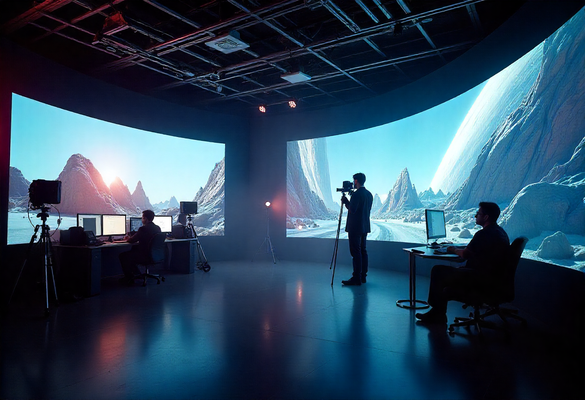Complete Guide to Virtual Production Services: What Every Filmmaker Needs to Know

The film industry has fundamentally transformed with the introduction of virtual production services, revolutionizing how movies, television shows, and commercials are created. This technology allows filmmakers to blend physical and digital worlds in real-time, creating immersive environments that were previously impossible or prohibitively expensive to achieve.
Modern virtual production solutions have become essential tools for directors, producers, and cinematographers seeking to streamline their workflows while maintaining creative control. From LED walls and real-time rendering to motion capture integration, these services provide filmmakers with unprecedented flexibility and cost-effectiveness.
Understanding Virtual Production Services in Modern Filmmaking
Virtual production services encompass a wide range of technologies and techniques that enable filmmakers to create, visualize, and capture content in digital environments. These services bridge the gap between traditional filmmaking methods and cutting-edge digital technology, allowing creative teams to work more efficiently while achieving higher production values.
The core concept revolves around real-time rendering technology that displays digital environments on LED screens during filming. This approach eliminates the need for extensive green screen work and post-production compositing, as actors can perform in realistic environments that respond naturally to camera movements and lighting changes.
Virtual production company providers offer specialized expertise in implementing these complex systems, managing everything from hardware installation to creative consulting. Their role extends beyond technical support to include artistic guidance, helping filmmakers realize their creative vision through digital innovation.
Essential Virtual Production Tools and Equipment
Modern virtual production tools form the backbone of any successful virtual production workflow. LED wall systems serve as the primary display technology, providing high-resolution backgrounds that can be viewed directly by cameras without post-production replacement.
Real-time rendering engines like Unreal Engine and Unity power these displays, creating photorealistic environments that respond instantly to camera movements. Motion tracking systems ensure perfect synchronization between physical camera movements and digital environment perspectives, maintaining visual consistency throughout filming.
Camera tracking technology represents another crucial component, using advanced sensors and software to monitor camera position and orientation in real-time. This data feeds directly into the rendering engine, ensuring that digital backgrounds move naturally with camera movements, creating convincing parallax effects and proper perspective shifts.
Virtual production equipment also includes specialized lighting systems designed to work harmoniously with LED displays. These fixtures can be synchronized with the digital environment, creating realistic lighting interactions between virtual and physical elements in the scene.
Top Virtual Production Companies Leading the Industry
ARWALL stands at the forefront of virtual production services, offering state-of-the-art LED XR stages and innovative ARFX Infinite Studio solutions. Their technology enables filmmakers to create unlimited virtual environments with real-time rendering capabilities, making them a preferred choice for major productions worldwide.
Industrial Light & Magic (ILM) pioneered virtual production with their StageCraft technology, used in productions like The Mandalorian. Their LED volume stages have set industry standards for quality and performance, inspiring widespread adoption across the entertainment industry.
Lux Machina specializes in large-scale LED installations and virtual production consulting. They've worked on numerous high-profile projects, providing both technical expertise and creative guidance to filmmakers adopting virtual production workflows.
NEP Virtual Studios offers turnkey virtual production solutions, including mobile LED stages that can be deployed on location. Their flexible approach makes virtual production accessible to productions of various scales and budgets.
PIXOMONDO combines virtual production services with traditional VFX expertise, offering integrated solutions that span pre-production through post-production. Their approach helps filmmakers seamlessly blend virtual and traditional production techniques.

Benefits of Professional Virtual Production Services
Professional virtual production services offer significant advantages over traditional filmmaking methods. Cost reduction represents one of the most compelling benefits, as virtual environments eliminate the need for expensive location shoots and extensive set construction.
Time savings prove equally valuable, as filmmakers can quickly switch between different environments without lengthy setup changes. This flexibility allows for more efficient shooting schedules and reduces overall production timelines.
Creative control reaches new levels with virtual production, as directors can visualize and modify environments in real-time during filming. This immediate feedback enables more informed creative decisions and reduces the uncertainty often associated with green screen productions.
The technology also improves actor performances by providing realistic environments that help performers connect with their surroundings. Instead of acting against blank green screens, actors can see and react to their virtual environment, leading to more authentic performances.
Choosing the Right Virtual Production Partner
Selecting an appropriate virtual production company requires careful consideration of several factors. Technical expertise stands as the primary criterion, as virtual production involves complex systems that require specialized knowledge to operate effectively.
Experience with similar projects provides valuable insight into a company's capabilities. Look for providers who have successfully completed productions in your genre or scale, as this experience translates directly to better service and problem-solving abilities.
Equipment quality and availability affect both the visual results and production scheduling. Top-tier virtual production equipment produces superior image quality and reliability, while adequate availability ensures your production timeline remains on track.
Support services throughout the production process distinguish professional providers from basic equipment rental companies. Look for partners who offer pre-production planning, on-set technical support, and post-production integration services.

Implementation Strategies for Virtual Production Success
Successful virtual production implementation begins with thorough pre-production planning. Teams must understand how virtual environments will integrate with physical elements, ensuring seamless blending between digital and practical components.
Technical rehearsals play a crucial role in virtual production success. These sessions allow crew members to familiarize themselves with new workflows and identify potential issues before principal photography begins.
Collaboration between departments becomes even more critical in virtual production. Visual effects artists, cinematographers, and production designers must work closely together to ensure consistent creative vision across all elements.
Budget allocation for virtual production services should account for both equipment rental and technical support services. While initial costs may seem high, the long-term savings in post-production and location expenses often justify the investment.
Future Trends in Virtual Production Technology
Artificial intelligence integration promises to streamline many aspects of virtual production workflow. AI-powered tools can automatically adjust lighting, optimize rendering performance, and even suggest creative alternatives based on scene requirements.
Improved display technology continues advancing, with higher resolution LED panels and better color accuracy becoming standard. These improvements enhance the realism of virtual environments and reduce the post-production work required for final images.
Cloud-based rendering services are making high-quality virtual production tools more accessible to smaller productions. These services provide on-demand processing power without requiring significant hardware investments.
Real-time ray tracing technology creates more photorealistic lighting and reflections in virtual environments. As this technology becomes more accessible, virtual production quality will continue improving while processing requirements decrease.

Cost Considerations and ROI Analysis
Virtual production services pricing varies significantly based on project scope and duration. Daily rates for LED stage rental typically range from $10,000 to $50,000, depending on stage size and included services.
Equipment costs represent the largest expense category, including LED panels, cameras tracking systems, and rendering hardware. However, these costs often offset traditional expenses like location fees, set construction, and extensive post-production work.
Labor costs for specialized technicians add to overall expenses but prove essential for smooth operations. Experienced virtual production crews prevent costly delays and ensure optimal system performance throughout filming.
Return on investment calculations should include both direct cost savings and indirect benefits like reduced shooting schedules and improved creative flexibility. Many productions find that virtual production pays for itself through efficiency gains alone.
Conclusion
Virtual production services have revolutionized modern filmmaking by providing unprecedented creative flexibility and cost-effectiveness. From LED wall installations to real-time rendering solutions, these technologies enable filmmakers to create stunning visual content while streamlining production workflows.
Success with virtual production depends on choosing the right technology partner, proper pre-production planning, and understanding how these tools integrate with traditional filmmaking techniques. As the technology continues advancing, virtual production will become increasingly accessible to productions of all scales.
The future of filmmaking lies in the seamless integration of physical and digital worlds, and virtual production solutions provide the foundation for this transformation. By embracing these technologies now, filmmakers position themselves at the forefront of industry innovation.
Frequently Asked Questions
Q: What are virtual production services and how do they work?
A: Virtual production services combine real-time rendering technology with LED display systems to create immersive filming environments. These services use powerful computers to generate photorealistic digital backgrounds that display on LED walls in real-time, allowing actors to perform in realistic environments while cameras capture the scene naturally.
Q: How much do virtual production services typically cost?
A: Virtual production costs vary based on project scale and duration. Daily LED stage rental rates range from $10,000 to $50,000, while complete virtual production equipment packages can cost significantly more. However, these expenses often offset traditional costs like location fees and extensive post-production work.
Q: What equipment is needed for virtual production?
A: Essential virtual production tools include LED wall systems, real-time rendering computers, camera tracking hardware, and specialized lighting equipment. Additional components like motion capture systems and haptic feedback devices may be required depending on project requirements.
Q: Which companies provide the best virtual production services?
A: Leading virtual production company providers include ARWALL, Industrial Light & Magic, Lux Machina, NEP Virtual Studios, and PIXOMONDO. Each offers different specializations and capabilities, so selection depends on specific project requirements and budget considerations.
Q: Can small productions afford virtual production technology?
A: Virtual production is becoming increasingly accessible to smaller productions through cloud-based rendering services and mobile LED stage solutions. Many virtual production services providers offer scalable options that can accommodate various budget levels and production scales.
Q: What are the main benefits of using virtual production?
A: Key benefits include significant cost savings on location shoots and set construction, reduced post-production time, improved creative control during filming, and better actor performances through realistic environments. Virtual production also provides greater scheduling flexibility and reduces weather-related delays.




